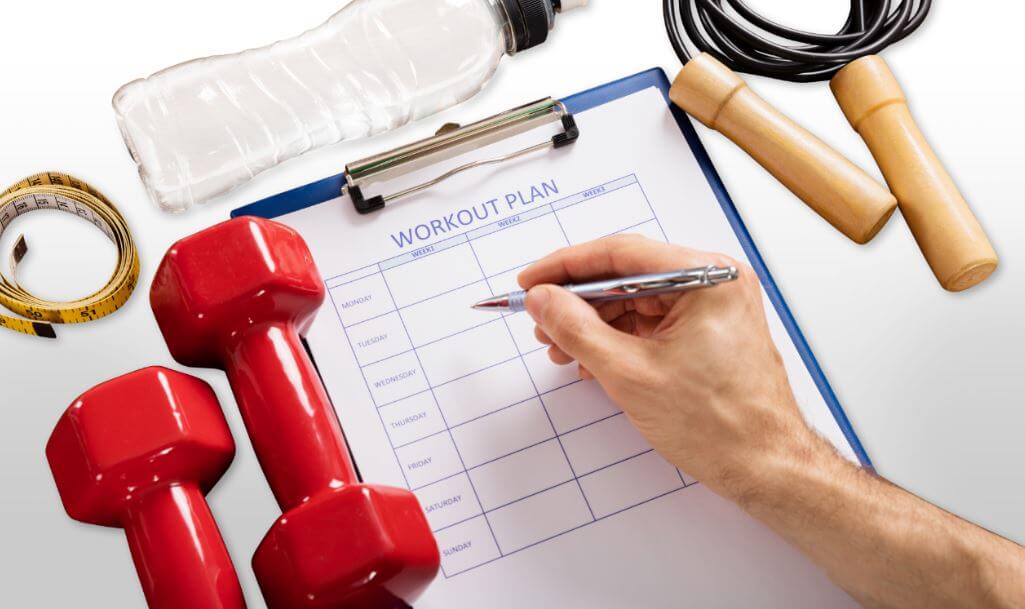Training Plan - Tips and Tricks for Creating Yours

We cannot train each one of the major muscle groups in our body every single day. Furthermore, we shouldn’t do the same exercises at the same intensity every day. That’s why, every athlete should create a training plan to follow so that they can perform to their full potential.
If you attend a gym or you train with a personal trainer, it is likely that someone will plan your routines. That’s great! Anyone who partakes in any type of training should have a training plan, even if it means making one up for yourself.
Why is a training plan so important? Firstly, to workout effectively, you should have specific objectives, whether weekly or monthly, and a strategy for achieving them. For example, if you practice volleyball, and you think that you should improve your vertical, you’d have to do exercises to increase your power and muscle mass.
The ideal, in this case, is not to arrive at the gym or start training by doing whatever exercises come to mind. It would be necessary to create a training plan with a series of exercises specifically designed to help you reach your objective.
How to create a training plan

In the first instance, we should list the various factors that we need to take into account when creating a training plan. Here are some of the most relevant factors:
- Physical condition of the athlete
- Purpose
- Previous completed workouts
- Availability
- Risk of injury
- Daily energy expenditure
- Workout preferences
To improve your sports performance, and even to improve upon a specific skill within a sport, one exercise in particular will prove to be the most effective. In general, most athletes aim to increase muscle mass, tone their bodies, and burn fat.
Considering this criteria, we should create a routine that’s focused on strength training. This is because strength training is the most effective way to exchange fat for muscles and flaunt a toned and slender figure.
However, it’s also important to dedicate a portion of your routine to cardiovascular exercises. After performing a series of exercises with weights, where muscle fibers break and muscle mass increases, this is the ideal moment to burn even more fat. You can do this on a bicycle or a treadmill. Running in place is also a great option.
Vary the intensity of your training plan

You can train for five days a week, but the intensity should vary from day to day. If you’re performing strength training exercises, you should include less intense activities and exercises every other day. During these less intense days, you can work on your cardio or do low-intensity exercises (around 60 per cent of your full effort). The same concept applies if you typically train with intense cardio.
If you prefer to have a good time as you workout, you can try fun activities that keep you active during your less intense days. For example, you can try yoga, zumba, Pilates, or other sports. Always remember not to replace your principal training with this type of training. You can also try these activities on the weekends.
Taking this recommendation one step further, it’s important not to underestimate the value of rest. Rest should be a part of your training plan, as it’s just as important. When we rest, we recover our energy, reconstruct our muscles, and recharge our minds with renewed energy.
Moments of training that you don’t plan for
The organization and planning that we talked about earlier generally takes place among other unplanned training activities. What are they?
One clear example is to complete work around the house that requires strength and effort. More specifically, if you’ve been moving furniture or other heavy objects, it makes sense to skip the heavy lifting in the gym and opt for a cardio or HIIT routine instead.
The same applies to playing sports. If you decided to spend the afternoon playing soccer or basketball with friends, you probably shouldn’t head straight to the gym to perform a leg muscle routine. Instead, you should take the opportunity to work your chest or back.
Creating an effective training plan requires taking into account all of these details. Although they may seem small or of little influence, forgetting these details can lead to injury.
Set realistic objectives

Creating an effective training plan also requires reviewing your own obligations and preferences. You’ll have to decide if you prefer to train in the morning, afternoon, or at night. Don’t forget to consider what time of day you perform at your best.
Likewise, according to your physical condition and availability, you should set goals for yourself that you think are attainable. By setting goals, you’ll be able to see improvements, which will be a great source of motivation to continue with your training plan.
If you practice a sport and train for it, try to measure your progress. Keep track of your ability to jump, react on defense, run for distance or speed, reach full acceleration, etc. Nowadays, technology allows us to track all of the stats easily using our cell phones.
It’s clear that by creating and sticking to an effective training plan, you’ll be able to experience great progress. You can use any accessible tools, including modern technology, to help you to combine workouts and create an effective training plan. In no time, you’ll experience progress and a long list of benefits, both in the gym and in your sport.
We cannot train each one of the major muscle groups in our body every single day. Furthermore, we shouldn’t do the same exercises at the same intensity every day. That’s why, every athlete should create a training plan to follow so that they can perform to their full potential.
If you attend a gym or you train with a personal trainer, it is likely that someone will plan your routines. That’s great! Anyone who partakes in any type of training should have a training plan, even if it means making one up for yourself.
Why is a training plan so important? Firstly, to workout effectively, you should have specific objectives, whether weekly or monthly, and a strategy for achieving them. For example, if you practice volleyball, and you think that you should improve your vertical, you’d have to do exercises to increase your power and muscle mass.
The ideal, in this case, is not to arrive at the gym or start training by doing whatever exercises come to mind. It would be necessary to create a training plan with a series of exercises specifically designed to help you reach your objective.
How to create a training plan

In the first instance, we should list the various factors that we need to take into account when creating a training plan. Here are some of the most relevant factors:
- Physical condition of the athlete
- Purpose
- Previous completed workouts
- Availability
- Risk of injury
- Daily energy expenditure
- Workout preferences
To improve your sports performance, and even to improve upon a specific skill within a sport, one exercise in particular will prove to be the most effective. In general, most athletes aim to increase muscle mass, tone their bodies, and burn fat.
Considering this criteria, we should create a routine that’s focused on strength training. This is because strength training is the most effective way to exchange fat for muscles and flaunt a toned and slender figure.
However, it’s also important to dedicate a portion of your routine to cardiovascular exercises. After performing a series of exercises with weights, where muscle fibers break and muscle mass increases, this is the ideal moment to burn even more fat. You can do this on a bicycle or a treadmill. Running in place is also a great option.
Vary the intensity of your training plan

You can train for five days a week, but the intensity should vary from day to day. If you’re performing strength training exercises, you should include less intense activities and exercises every other day. During these less intense days, you can work on your cardio or do low-intensity exercises (around 60 per cent of your full effort). The same concept applies if you typically train with intense cardio.
If you prefer to have a good time as you workout, you can try fun activities that keep you active during your less intense days. For example, you can try yoga, zumba, Pilates, or other sports. Always remember not to replace your principal training with this type of training. You can also try these activities on the weekends.
Taking this recommendation one step further, it’s important not to underestimate the value of rest. Rest should be a part of your training plan, as it’s just as important. When we rest, we recover our energy, reconstruct our muscles, and recharge our minds with renewed energy.
Moments of training that you don’t plan for
The organization and planning that we talked about earlier generally takes place among other unplanned training activities. What are they?
One clear example is to complete work around the house that requires strength and effort. More specifically, if you’ve been moving furniture or other heavy objects, it makes sense to skip the heavy lifting in the gym and opt for a cardio or HIIT routine instead.
The same applies to playing sports. If you decided to spend the afternoon playing soccer or basketball with friends, you probably shouldn’t head straight to the gym to perform a leg muscle routine. Instead, you should take the opportunity to work your chest or back.
Creating an effective training plan requires taking into account all of these details. Although they may seem small or of little influence, forgetting these details can lead to injury.
Set realistic objectives

Creating an effective training plan also requires reviewing your own obligations and preferences. You’ll have to decide if you prefer to train in the morning, afternoon, or at night. Don’t forget to consider what time of day you perform at your best.
Likewise, according to your physical condition and availability, you should set goals for yourself that you think are attainable. By setting goals, you’ll be able to see improvements, which will be a great source of motivation to continue with your training plan.
If you practice a sport and train for it, try to measure your progress. Keep track of your ability to jump, react on defense, run for distance or speed, reach full acceleration, etc. Nowadays, technology allows us to track all of the stats easily using our cell phones.
It’s clear that by creating and sticking to an effective training plan, you’ll be able to experience great progress. You can use any accessible tools, including modern technology, to help you to combine workouts and create an effective training plan. In no time, you’ll experience progress and a long list of benefits, both in the gym and in your sport.
This text is provided for informational purposes only and does not replace consultation with a professional. If in doubt, consult your specialist.








